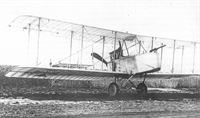
Описание
Страна: Германия
Год: 1916
Варианты
- Friedrichshafen - FF27 - 1914 - Германия
- Friedrichshafen - FF31 - 1914 - Германия
- Friedrichshafen - FF37 - 1916 - Германия
- O.Thetford, P.Gray German Aircraft of the First World War (Putnam)
- J.Herris Friedrichshafen Aircraft of WWI (A Centennial Perspective on Great War Airplanes 21)
-
J.Herris - Friedrichshafen Aircraft of WWI /Centennial Perspective/ (21)
Fdh FF37 (1915). Combat biplane from 1915 with pusher propeller, 150 hp Benz Bz III, covered nose, lattice fuselage and undercarriage. Only one prototype was built.
The sole prototype Friedrichshafen FF37; the structure shows clearly through the fabric. -
O.Thetford, P.Gray - German Aircraft of the First World War /Putnam/
A fine shot of the rarely pictured two seat, pusher-engined Friedrichshafen FF37, or C I to give it its military designation. Of early 1916 vintage, the experimental FF37's general layout appears to have been influenced by that of the Royal Aircraft Factory's F.E.2, following the British practice of seating the gunner in the nose, forward of the pilot. The FF37 was destined never to progress beyond the prototype stage.
O.Thetford, P.Gray German Aircraft of the First World War (Putnam)
Friedrichshafen FF 37
Although no details are available, this aircraft was undoubtedly simply a land version of the FF 31 "pusher" seaplane. Engine, 150 h.p. Benz Bz III.
Описание:


